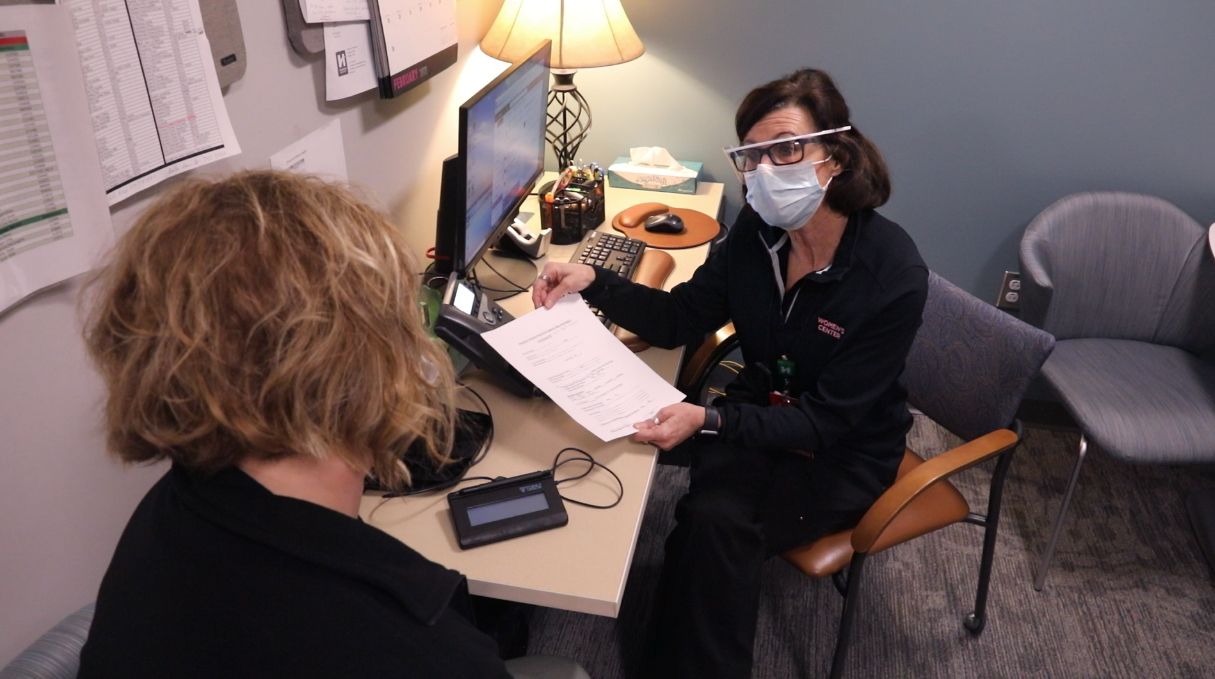
What is 3D Mammography or digital breast tomosynthesis?
Digital breast tomosynthesis, or 3D mammography, is a new FDA-approved screening and diagnostic tool designed for detecting breast cancer. Using this powerful technology, radiologists are able to examine each layer of the breast tissue and more accurately find abnormalities.
Return to top ↑
What is the difference between 3D mammogram and a traditional mammogram?
3D mammograms provide a clearer scan than a 2D mammogram or ultrasound, allowing our team to detect smaller cancers, pinpoint tumor size and location, and reduce follow-up testing.
Return to top ↑
What is the difference between a mammogram screening and a diagnostic mammogram?
A screening mammogram is an x-ray of the breast and is routinely administered to detect breast cancer in patients who have no apparent symptoms. Diagnostic mammograms are used if a change is seen on a screening mammogram or if the patient has signs or symptoms of abnormality such as pain, lump or other change in the breast.
Return to top ↑
Who can have a 3D mammogram?
The physicians at Hendricks Regional Health believe all patients can benefit from a 3D mammogram and recommend they take advantage of its advanced capabilities.
Return to top ↑
Does insurance cover 3D mammogram screenings?
Patient should check with their insurance company for coverage information.
Return to top ↑
What type of financial assistance is available to those who qualify?
Through the wonderful support of the Indiana Breast Cancer Awareness Trust (IBCAT), Hendricks Regional Health is able to serve women in need from screening to survivorship. Grants from IBCAT help us to provide free mammography and diagnostic services to individuals throughout our community who qualify financially and medically. To learn more about your options and/or to schedule a vital screening, call (317) 745-3404, request a mammogram online or schedule directly in MyChart.
Return to top ↑
When should I get a mammogram?
It is recommended to begin annual mammogram screenings at the age of 40. However, this may change if you have a family history of breast cancer, are at high risk, or if your physician has discussed starting your screenings at an earlier age.
Return to top ↑
Do I need a referral to get a mammogram?
You do not need a physician referral or a doctor’s note to schedule a screening mammogram. A diagnostic mammogram does require an order from a physician. To schedule a mammogram at Hendricks Regional Health, call (317) 745-3404, request a mammogram online or schedule directly in MyChart.
Return to top ↑
How long does a mammogram take?
A standard screening mammogram takes about 15 minutes. A diagnostic mammogram takes about 30 minutes. If our staff determines a patient is at high risk during their mammogram appointment, the length of the visit may be extended.
Return to top ↑
How much radiation will I be exposed to?
You will be exposed to a very small dose of radiation during your mammogram, as it is required for the exam. The risk of harm is extremely low and the benefits of mammography nearly always outweigh the potential harm from the radiation exposure.
Return to top ↑
Are mammograms painful?
Some patients find a mammogram screening to be uncomfortable; especially those with sensitive breasts. Schedule your mammogram during a time when your breasts are not as sensitive. For premenopausal women, this would be around one week after your menstrual period.
Return to top ↑
What do I need to prepare for the exam?
If you’re a premenopausal woman, schedule your mammogram for the week after your menstrual period. Avoid wearing deodorant, powder, lotion or ointment around your chest area. If you find mammograms to be uncomfortable, consider taking an over-the-counter pain medication an hour before your exam.
Return to top ↑
How will I be informed of the results from the mammogram?
Results from a standard screening are mailed the following day. Results from a diagnostic mammogram are made available before the patient leaves from the appointment. If a follow-up is needed, such as a biopsy, it may be scheduled the same day.
Return to top ↑
How do I know if I’m at high risk for developing breast cancer?
If you have a family history of breast cancer, or if a physician has determined that you have dense breast tissue or another personal risk factor, then you may be at high risk. During every mammogram, our staff will determine if a patient is at higher risk and will discuss next steps, which could include a genetic risk evaluation and high risk surveillance. If you have any questions or concerns about your breast cancer risk, our team is happy to help at (317) 745-3404.
Return to top ↑
Is genetic testing available for breast cancer?
At the Hendricks Regional Health High Risk Prevention Clinic, we offer a genetic risk evaluation for patients with a personal and/or family history of cancer. This evaluation is a blood test that screens for over 20 genes across 8 important cancer types including breast, ovarian, colorectal, uterine, melanoma, pancreatic, stomach and prostate.
Return to top ↑
Need to Schedule a Mammogram?
Mammography Info » Breast & Bone Center »